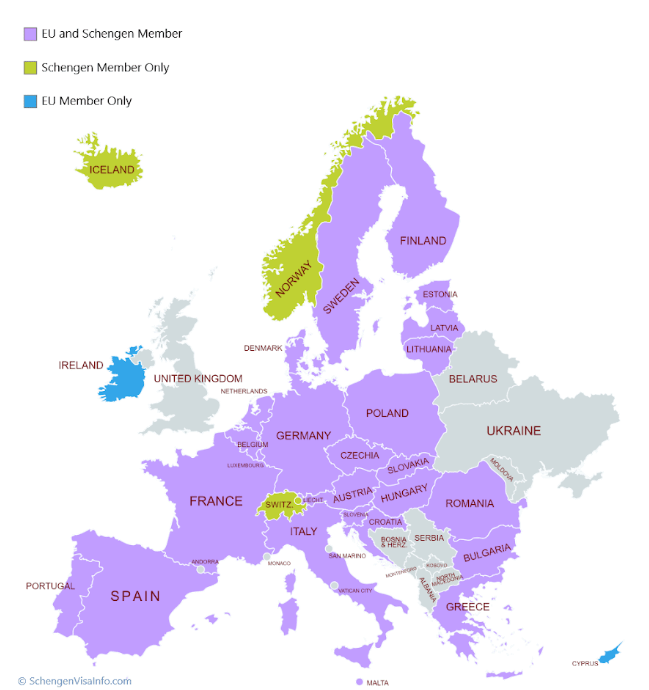Austria Travel Visas
Austria is a member of the European Union and the Schengen zone and Austria is a party to the Schengen Agreement (more below).
IMPORTANT
The information on this page is not official and ONLY meant to be used as a starting point for your enquiries about Austrian visa requirements. Entry requirements are updated regularly and you should refer to the advice from the Austrian Consulate in your country.
This article may contain compensated links. See our full disclaimer here. If you purchase through any of these links, we may earn a small commission at no extra cost to you. The commissions help us provide valuable travel tips and guides for free. Thank you!

Passports
Your passport must have at least three months of validity left on the date you intend to leave the EU.
BUT It is strongly recommended that your passport is valid for at least six months when entering Austria.
In addition, your passport should have been issued within the last ten years (even if it has six months or more left).
Visa Information
Citizens of the United States, Australia, Canada, United Kingdom, United Arab Emirates and New Zealand (and others) are visa-exempt and may enter Austria and stay up to 90 days in a 180-day period without a tourist visa.
Check the official list HERE to ensure that you do not need a visa before travelling to Austria.
For citizens of non-visa-exempt countries, you must apply for an Austrian tourist Visa C through the Austrian embassy or consulate in your country.
Information about Visas and requirements can be found on the AUSTRIAN GOVERNMENT WEBSITE
Schengen Zone
Many European visitors mistakenly believe they can travel for more than three months in Europe, which is not the case because of the 90/180 Schengen Rule. This is a problem encountered by thousands of travellers annually and a regularly discussed question.
The Schengen Zone currently comprises of 29 European countries that agreed to create common entry and exit requirements, allowing border-free travel. The area encompasses most EU countries except Cyprus, Ireland, and the United Kingdom.
Current Schengen area countries
Austria, Belgium, Bulgaria, Croatia, Czechia, Denmark, Estonia, Finland, France, Germany, Greece, Hungary, Iceland, Italy, Latvia, Liechtenstein, Lithuania, Luxembourg, Malta, the Netherlands, Norway, Poland, Portugal, Romania, Slovakia, Slovenia, Spain, Sweden and Switzerland.
**Bulgaria and Romania joined the Schengen Zone on 31 March 2024.

Image from Schengenvisa.com
90/180 Rule
Non-European Union (EU) and non-European Economic Area (EEA) citizens can only stay in EU member states of the Schengen Area for a maximum of 90 days within any 180-day period and is calculated backwards from the entry date. Basically, you can visit for 3 months, and then you must leave for 3 months before you can return.
Plan your visit with the SCHENGEN VISA CALCULATOR
- You can visit multiple European countries during your 90-day visit to the Schengen Area,
- But, the 90-day limit applies to the cumulative total of your stay in the entire Schengen Area.
- The 90-day clock starts at your first entry to the Schengen Zone – once day 181 hits- the clock resets.
If you intend to stay in Austria or the Schengen zone for more than 90 but less than 6 months AND are neither an EU nor an EFTA citizen,
1. You must apply for a Visa D before you enter Austria. A Visa D allows entitles you to stay in the country that issued the visa for up to 6 months. 𝐁𝐔𝐓 you are still only permitted to stay in other Schengen member states for up to 90 days per period in any 180 days.
2. Plan on travelling back and forth between Schengen and non-Schengen countries. Possibilities include visiting the United Kingdom or the Balkans (excluding Bulgaria, Croatia, Greece, Romania and Slovenia) for 90 days before re-entering the Schengen Zone.
What happens if stay more than 90 days in the Schengen Zone
The immigration authorities have registered in their databases every person that enters and leaves the Schengen, and every overstaying, even just for a day, is recorded.
A non-EU national who stays in the Schengen area beyond 90 days (without a residence permit or long-stay visa) is illegally present. Overstays can result in:
- Immediate deportation
- Fine
- Ban from entering the Schengen Zone for a specific amount of time.
Please refer to the official EU WEBSITE for up-to-date information on Schengen Visas.
ETIAS
In mid-2025, the EU is expected to introduce the requirement for visa-Exempt countries to complete a European Travel Information and Authorisation System (ETIAS).
It is similar to the US ESTA, the Canadian eTA or the Australian ETA.
The ETIAS will be valid for up to three years.
Applications are not yet being accepted. Information will be updated on the official ETIAS WEBSITE.

Expert advice to help you plan your Austria holiday.
Book an Austria Trip Planning Consultation
We help you plan your dream Austrian holiday.
The Wanderlustria Trip Planning Service provides advice on everything you need to know about planning your holiday to Austria- from hotels to tours, where to get the best tickets, train and road trips and share our favourite places and activities to ensure your Austria holiday is memorable.
Trip Planning
Click on one of the topics below to start planning your dream trip to Austria.
Wanderlusting where else to visit in Austria?
Read these Articles for Recommendations, Tips and Advice on Sights to See and Things to Do
Related Articles
Related
The Ultimate Travel Packing Tips
Our Top 15 international travel packing tips will help you organise your packing list for Europe. Packing the right things helps to ensure your trip overseas is fun, safe, and stress-free.
Austria’s Christmas Market Date Guide
This guide will help you plan the ultimate Christmas holiday in Austria.
Discover the unique magic of an Austrian Christmas by visiting Christkindlmarkt ( Austria Christmas Markets).
How to Use your Mobile Phone in Austria
Ensure that you stay connected while you travel in Austria. Here is what you need to know about how to use your mobile phone in Austria while travelling.
Chief Wanderlust'er. I love helping you discover the beautiful cities, breathtaking scenery and amazing experiences in Austria.
Founder of the Austria Wanderlust Travel Planning website, the Austria Travel Planning Facebook group and director of Wanderlustria eU.














